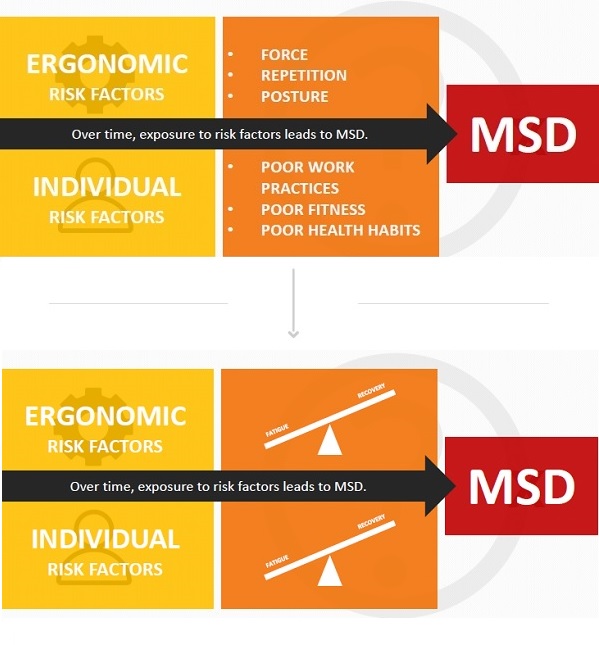What are MSDs?
Musculoskeletal disorders (MSDs) are injuries and disorders that affect the human body’s movement or musculoskeletal system such as muscles, joints, tendons, ligaments, nerves, bones and the localized blood circulation system, that are caused or aggravated primarily by work and by the effects of the immediate environment in which work is carried out.
Most MSDs are cumulative disorders, resulting from repeated exposure to high or low intensity loads over a long period of time. However, MSDs can also be acute traumas, such as fractures, that occur during an accident.
These disorders mainly affect the back, low back, neck, shoulders and upper limbs, but can also affect the lower limbs. Some MSDs, such as carpal tunnel syndrome in the wrist, are specific because of their well-defined signs and symptoms. Others are non-specific because only pain or discomfort exists without evidence of a clear specific disorder.
The Cause of MSDs – Exposure to Risk Factors
When a worker is exposed to MSD risk factors, they begin to fatigue. When fatigue outruns their body’s recovery system, they develop a musculoskeletal imbalance. Over time, as fatigue continues to outrun recovery and the musculoskeletal imbalance persists, a musculoskeletal disorder develops.

These risk factors can be broken up into two categories: ergonomic risk factors and individual-related risk factors.
There are three primary ergonomic risk factors.
High task repetition. Many work tasks and cycles are repetitive in nature, and are frequently controlled by hourly or daily production targets and work processes. High task repetition, when combined with other risks factors such high force and/or awkward postures, can contribute to the formation of MSDs. A job is considered highly repetitive if the cycle time is 30 seconds or less.
Forceful exertions. Many work tasks require high force loads on the human body. Muscle effort increases in response to high force requirements, increasing associated fatigue which can lead to MSDs.
Repetitive or sustained awkward postures. Awkward postures place excessive force on joints and overload the muscles and tendons around the effected joint. Joints of the body are most efficient when they operate closest to the mid-range motion of the joint. Risk of MSDs is increased when joints are worked outside of this mid-range repetitively or for sustained periods of time without adequate recovery time.
Individual risk factors include:
Poor work practices. Workers who use poor work practices, body mechanics and lifting techniques are introducing unnecessary risk factors that can contribute to MSDs. These poor practices create unnecessary stress on their bodies that increases fatigue and decreases their body’s ability to properly recover.
Poor overall health habits. Workers who smoke, drink excessively, are obese, or exhibit numerous other poor health habits are putting themselves at risk for not only musculoskeletal disorders, but also for other chronic diseases that will shorten their life and health span.
Poor rest and recovery. MSDs develop when fatigue outruns the worker’s recovery system, causing a musculoskeletal imbalance. Workers who do not get adequate rest and recovery put themselves at higher risk.
Poor nutrition, fitness and hydration. For a country as developed as the United States, an alarming number of people are malnourished, dehydrated and at such a poor level of physical fitness that climbing one flight of stairs puts many people out of breath. Workers who do not take care of their bodies are putting themselves at a higher risk of developing musculoskeletal and chronic health problems.
Ergonomic Interventions for Preventing MSDs among Office Workers
Office works are among jobs that have high prevalence of MSDs. Prolonged sitting, work with computer, repetitive works, static postures, and bad environmental conditions are some of the causes for MSDs. Ergonomic interventions include physical, organizational and cognitive components.
Physical ergonomic interventions. Physical ergonomic interventions include improving the equipment and environment of the workplace. The aim of these methods is to reduce the physical strain to the musculoskeletal system, thus reducing risk of injury. It’s found that the use of an arm support or a mouse based on neutral posture may prevent MSDs of the neck and shoulder. Workstation adjustment, and sit-stand desks do not have an effect on upper limb pain compared to no intervention.
Organizational ergonomic interventions. Meanwhile, organizational ergonomic interventions consist of allowing optimum workplace and rest time for the musculoskeletal system to recover from fatigue, thus reducing the risk of long-term injury. It’s found that supplementary breaks may reduce neck and upper limb discomfort among data entry workers.
Cognitive ergonomic interventions. Cognitive ergonomic interventions consist of improving mental processes such as perception, memory, reasoning and motor response through modifying work processes and training. The aim of these methods is to reduce mental workload, increase reliability and reduce error, which may have an indirect effect on reducing strain on the musculoskeletal system.
You can refer to the following three textbooks for detailed information:
1. Ergonomics and Musculoskeletal Disorders (MSDs) in the Workplace: a Forensic and Epidemiological Analysis
2. Musculoskeletal Disorders and the Workplace Low Back and Upper Extremities
3. Musculoskeletal Disorders in the Workplace: Principles and Practice (2nd Edition)
4. Occupational Ergonomics: Work Related Musculoskeletal Disorders of the Upper Limb and Back
5. Physical Therapy Prescriptions for Musculoskeletal Disorders
部分摘自于:
1. Factsheet 71-Introduction to Work-related Musculoskeletal Disorders
2. The Definition and Causes of Musculoskeletal Disorders
3. Prevalence of Musculoskeletal Disorders Among Office Workers
https://sites.kowsarpub.com/jjhs/articles/15012.html/
4. Ergonomic Interventions for Preventing Work-related Musculoskeletal Disorders of the Upper Limb and Neck among Office Workers